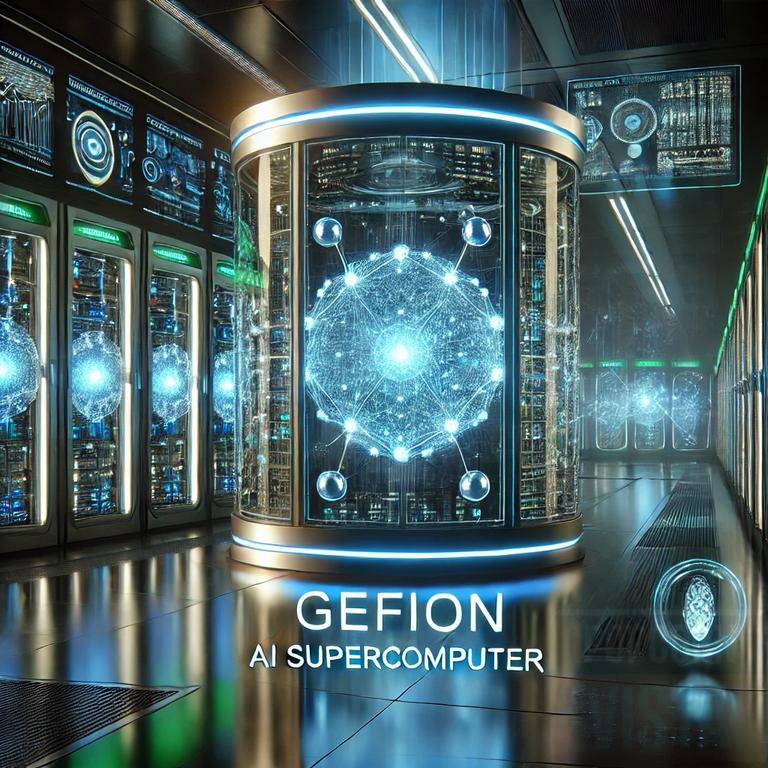In today’s rapidly evolving technological landscape, artificial intelligence (AI) stands as a cornerstone of progress. Among the latest advancements, the Gefion AI supercomputer in Denmark has emerged as a game-changer. Launched with much fanfare in October 2024, this cutting-edge system promises to redefine how researchers, businesses, and innovators tackle complex challenges. But what exactly makes Gefion so special? Let’s dive into its origins, capabilities, and the transformative impact it’s poised to deliver.
What Is the Gefion AI Supercomputer?
First and foremost, Gefion is Denmark’s flagship AI supercomputer, designed to accelerate large-scale AI projects. Named after a Norse goddess symbolizing abundance and foresight, it reflects Denmark’s ambition to lead in AI innovation. Built by Eviden, an Atos Group company, and powered by NVIDIA’s advanced technology, Gefion combines raw computational power with sustainability and accessibility.
Moreover, this supercomputer isn’t just another high-tech marvel reserved for tech giants. Instead, it’s a sovereign AI infrastructure, meaning Denmark controls its own data and computing resources. Consequently, this autonomy empowers the nation to address local and global challenges using its unique expertise and datasets.
A Collaborative Vision Takes Shape
The journey to Gefion began with a groundbreaking public-private partnership. Specifically, the Novo Nordisk Foundation and the Export and Investment Fund of Denmark (EIFO) joined forces to fund the Danish Centre for AI Innovation (DCAI), the entity behind Gefion. Meanwhile, NVIDIA contributed its state-of-the-art DGX SuperPOD architecture, ensuring top-tier performance.
Interestingly, this collaboration unfolded at lightning speed. In fact, from its announcement in March 2024 to its operational launch in October 2024, Gefion was realized in just six months. As a result, this rapid timeline underscores Denmark’s urgency to stay competitive in the global AI race.
Unpacking Gefion’s Technical Powerhouse
Now, let’s shift gears and explore what powers this technological titan. At its core, Gefion boasts 191 NVIDIA DGX H100 systems, totaling 1,528 NVIDIA H100 Tensor Core GPUs. Additionally, it integrates 382 Intel Xeon Platinum CPUs and connects via NVIDIA’s Quantum-2 InfiniBand networking. Together, these components deliver an astonishing 6 exaflops of FP8 AI performance.
For those unfamiliar, this level of power translates to lightning-fast data processing—ideal for AI-driven tasks like machine learning and quantum simulations. Furthermore, Gefion ranks 21st on the TOP500 list of the world’s most powerful supercomputers and 7th for storage speed on the IO500 list. Thus, it’s not just about brute strength; it’s also about efficiency and precision.
Sustainability at the Forefront
Beyond its technical specs, Gefion stands out for its eco-conscious design. Hosted by Digital Realty in an AI-ready data center, it runs on 100% renewable energy. Therefore, while it tackles massive computational workloads, it minimizes its environmental footprint. In an era where AI’s energy demands are under scrutiny, this commitment to sustainability sets Gefion apart.
How Gefion Is Transforming Industries
So, how does Gefion’s power translate into real-world impact? For starters, its capabilities are already reshaping multiple sectors. Below, we’ll explore some key areas where Gefion is making waves.
Revolutionizing Healthcare and Life Sciences
One of Gefion’s primary missions is to advance healthcare research. Through NVIDIA’s BioNeMo platform, researchers can leverage its power for drug discovery, disease modeling, and personalized medicine. For instance, Novo Nordisk, a global leader in pharmaceuticals, plans to use Gefion to accelerate breakthroughs in diabetes and obesity treatments.
Moreover, the supercomputer’s ability to process vast genomic datasets means faster insights into disease mutations and vaccine development. As a result, Denmark is positioning itself as a hub for life sciences innovation.
Boosting Climate Research and Green Solutions
Another exciting application lies in sustainability. Specifically, Gefion supports efforts to combat climate change by analyzing massive environmental datasets. For example, the Danish Meteorological Institute (DMI) is using it to develop AI-driven weather models that predict temperature and wind with near-perfect accuracy in minutes—not hours.
Consequently, these faster, more efficient forecasts enhance preparedness for extreme weather, aiding Denmark’s green transition goals. Additionally, Gefion’s potential to optimize energy systems further solidifies its role in creating a sustainable future.
Pioneering Quantum Computing
Looking ahead, Gefion is also a trailblazer in quantum research. By utilizing NVIDIA’s CUDA Quantum platform, it enables simulations of hybrid systems combining CPUs, GPUs, and quantum processing units. This capability is crucial because quantum computing promises to solve problems beyond the reach of classical systems.
Thus, Denmark’s researchers can now explore fault-tolerant quantum technologies, potentially unlocking new frontiers in science and industry.
Why Gefion Matters Globally
While Gefion is a Danish initiative, its impact extends far beyond national borders. First, its open-access model allows startups, academia, and enterprises worldwide to tap into its resources. Unlike proprietary systems owned by tech giants, Gefion democratizes access to cutting-edge AI tools.
Furthermore, its ranking among the world’s top supercomputers signals Denmark’s arrival as a global AI contender. In turn, this fosters international collaborations, attracting talent and investment to the region. Ultimately, Gefion’s success could inspire other nations to pursue sovereign AI infrastructures tailored to their needs.
A Catalyst for Societal Good
Perhaps most importantly, Gefion prioritizes societal benefits over pure profit. While commercial use is part of its model, the focus remains on solving pressing challenges like healthcare, climate change, and technological equity. Therefore, it offers a refreshing contrast to the product-driven AI race dominating Silicon Valley.
The Road Ahead for Gefion
As Gefion moves into full operation in 2025, its potential seems limitless. Already, pilot projects are underway, testing its capabilities across diverse fields. Meanwhile, plans to upgrade its hardware ensure it remains future-proof, adapting to the next wave of AI advancements.
However, challenges remain. Balancing commercial and academic access, maintaining security for sensitive data, and scaling its impact will require careful stewardship. Nevertheless, with DCAI’s leadership and NVIDIA’s expertise, Gefion is well-equipped to navigate these hurdles.
Conclusion: Gefion’s Bright Future
In conclusion, the Gefion AI supercomputer represents more than just technological prowess—it’s a symbol of ambition, collaboration, and purpose. By blending unmatched power with sustainability and accessibility, it’s paving the way for a new era of AI innovation. Whether it’s curing diseases, fighting climate change, or unlocking quantum mysteries, Gefion stands ready to shape a better tomorrow. So, as Denmark takes this bold step forward, the world watches eagerly, anticipating the ripple effects of this remarkable machine.

